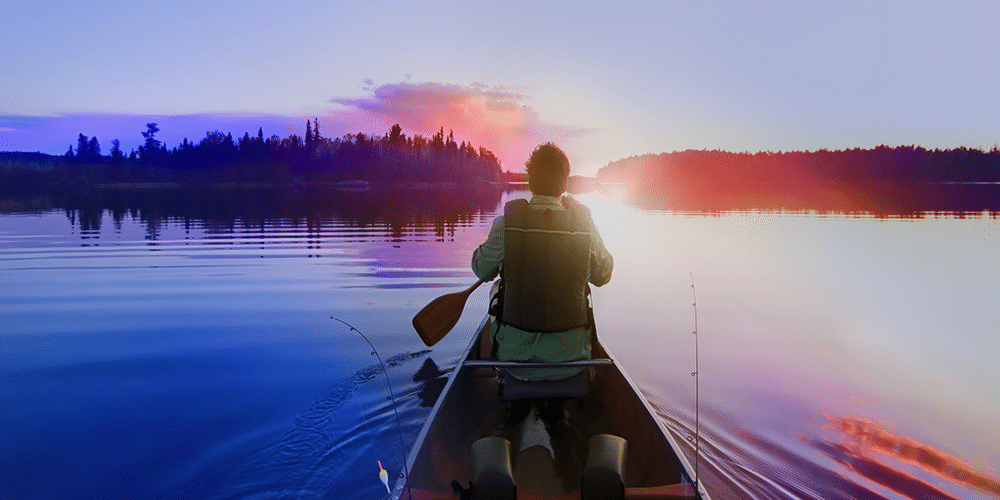Many people camping in the Midwest don’t like setting up near a crowd. When we take the time, energy, and vacation days to go camping, we often want quiet solitude, peaceful seclusion, and a connection with the outdoors. That’s hard to reach when so many people are crowding your site.
If you have been camping near too many crowds, if your outdoor getaway is ruined by loud, rambunctious “campers,” long lines to enter the park, and whole communities of luxury recreational vehicles, it’s time for a shift.
Keep reading to learn about a better game plan you can use to increase your chances of avoiding the campsite crowds. You’ll also get suggestions for locations where you can camp with fewer people surrounding your tent.
Camping with Solitude: 4 Strategies for a Better Experience
Off-Season Camping
If you only have one week a year to go camping, you might not want to go during the summer. This is when most people are out with their tents and campers, crowding parks and forests across the Midwest.
Instead, camp during the spring and fall. Camping during the off-season brings comfortable daytime temperatures (no smothering summer heat) and fewer mosquitoes, gnats, and horseflies to pester your skin throughout the day and night. If you are particularly adventurous (and well-equipped), you can camp during the winter for a remarkable experience.
Camp During the Week
Most people go camping in the summer and do most of their camping during the weekend. Setting up camp Friday and leaving Sunday morning is the typical itinerary for many camping getaways.
But when you camp on a Monday, Tuesday, or Wednesday, you’ll find fewer people crowding the camp, resulting in more space and more solitude. (Also, you can hike a secluded trail knowing that all your friends are bustling away at work!)
Camping on a weekday brings other benefits besides solitude. The rates for campgrounds can be lower, which is especially important for RV campers, and the best locations are more likely to be available. You may meet a different type of camper, such as quiet retirees, and access to amenities like showers and water stations will be faster.
The Further You Go, the More Solitude You’ll Get
Overall, the further you travel, the more solitude you’ll find. This can be interpreted in multiple ways.
First of all, if you live in a major metro area, the further you travel from your city, the more seclusion you’ll find. A park 10 miles from the metro will inevitably be more crowded than a park 200 miles from the nearest suburb.
Second, once you get to a park or forest, the further you travel inward, and the more difficult it is to reach the location, the more seclusion you’ll find. For example, if you hike three miles to your campground, you’ll see less of a crowd than if you drive to the nearest campsite and unload your gear.
The Harder the Camping, the Lesser the Crowd
If accessing the camp is easy, convenient, and comfortable, you will inevitably have more neighbors, especially when you are near amenities like bathrooms, showers, and shelters. However, if camping is challenging and can only be accessed by foot or canoe, you’ll see fewer people if there are no bathrooms or shelters. Sometimes you have to earn your solitude.
Earn your solitude by planning a more challenging experience. Find a campground that can only be accessed by hikers, one that only has a fire ring, and you’ll experience hard-earned peace and serenity.
6 Midwest Camping Options to Escape the Crowds
Wondering where to start? While there is likely an uncrowded campsite near you (especially if you use our tips), these spots will provide a quiet, peaceful, uncrowded camping experience.
Lower Wisconsin State Riverway, Southern Wisconsin
A little closer to home for many Midwesterners, the Lower Wisconsin River is a broad, mostly-shallow river that is perfect for canoes, kayaks, and flat-bottom boats. Best of all, it’s full of islands surrounded by sandbars, which are open for public camping. No reservation, no site payments, just peaceful river camping!
To access these sandbars, campers start somewhere upriver and enjoy a day of paddling and fishing. Around midday, campers begin to look for an island sandbar (of which there are many) to pitch their tent, start a fire, and camp for the night. Because the campsites can only be accessed by boat, there are usually fewer people crowding the sites. During the fall and spring, you may only see one, perhaps two other canoes, if any.
Boundary Waters, Northern Minnesota
Offering pristine waters, gorgeous forests, and the chance to escape crowded campsites, the Boundary Waters are considered a bucket-list location for any Midwestern outdoor enthusiast. While nationally famous, the Boundary Waters are not crowded, especially when compared to wilderness areas and camping locations near larger Midwest cities such as Minneapolis and Chicago.
With 1,200 miles of canoe routes and 2,000 designated campsites, this wilderness location offers some of the most secluded Midwest camping you can find.
Lake McConaughy, Northwest Nebraska
Lake McConaughy, located a few miles north of Ogallala, Nebraska, is a popular tourist destination in the summertime. The lake is the largest in the state, with over 30 miles of shoreline and over 4,500 acres of surface area. With so much space, you’ll most likely find a camping spot away from the crowds.
Campers can enjoy the many campgrounds and RV parks located along the shoreline. Boaters can take advantage of the lake’s many marinas and boat ramps. Boat and jet ski rentals are available at the Big Mac Marina.
Swimming and other water activities are popular here, as the lake is known for its clear, blue water and wide, sandy beaches. If you like to fish, you can also enjoy the lake’s excellent walleye, pike, white bass, and catfish fishing.
Lake McConaughy will surely provide an unforgettable camping experience with its wide range of activities.
Maquoketa Caves State Park, Eastern Iowa
Maquoketa Caves State Park in Iowa is a must-see park to explore and experience nature. Just outside the small town of Maquoketa, the park offers a variety of activities for visitors, including hiking, camping, fishing, and picnicking. The most popular attraction of this state park is the extensive cave system, with more than 6 miles of passageways. The caves are home to a variety of bats and other wildlife, as well as spectacular stalagmites and stalactites.
With its varied activities, Maquoketa Caves State Park is a great place for a camping vacation and is family-friendly. Visitors can explore the caves on self-guided tours or join a naturalist-guided tour led by park staff. The park also offers a variety of other activities, including horseback riding, swimming, and mountain biking.
The campground has 30 spacious and private campsites, and reservations can be made online.
Wayne National Forest, Southeast Ohio
Campers in Ohio who want to escape the large crowds should consider Wayne National Forest, located just a short drive southeast of Columbus. The park is a “patchwork of public land” encompassing over 250,000 square miles of stunning scenery. It’s largely dominated by Appalachian foothills and has stunning forests, natural landscapes, small bodies of water, and more.
The park has numerous camping options, including remote backpack camping. There is also dispersed camping for a more primitive experience, as well as campsites with picnic shelters and other amenities.
No matter where you live, it’s possible to escape the crowd while camping. Use these strategies and visit a few of our suggestions for a peaceful camping adventure.
Isle Royale National Park, Off Michigan’s Upper Peninsula
Many national parks are crowded with tourists. Yellowstone and Yosemite are notorious for large crowds. Yellowstone typically has over 4 million visitors a year, while monthly visitors to Yosemite range from about 110,000 to over 600,000 for peak months.
But some national parks are far less crowded, including those in the Midwest. Isle Royale National Park, an island in Lake Superior, had less than 26,000 visitors in 2021. Yes, the park is smaller than the massive western national parks, but because it requires a long boat ride to reach, this site offers an excellent chance to escape the crowd.
There are 36 campgrounds on the island, which are all accessible only by foot or boat.
Related Articles
- 7 Midwest Historic Sites That You Can Visit for FREE
- Weird Podcasts From the Midwest
- Best Vacation Spots in the Midwest
- Best Italian Cuisine in the Midwest
- 10 Outstanding High Schools in Iowa
- 10 Best Public High Schools in Missouri
###


